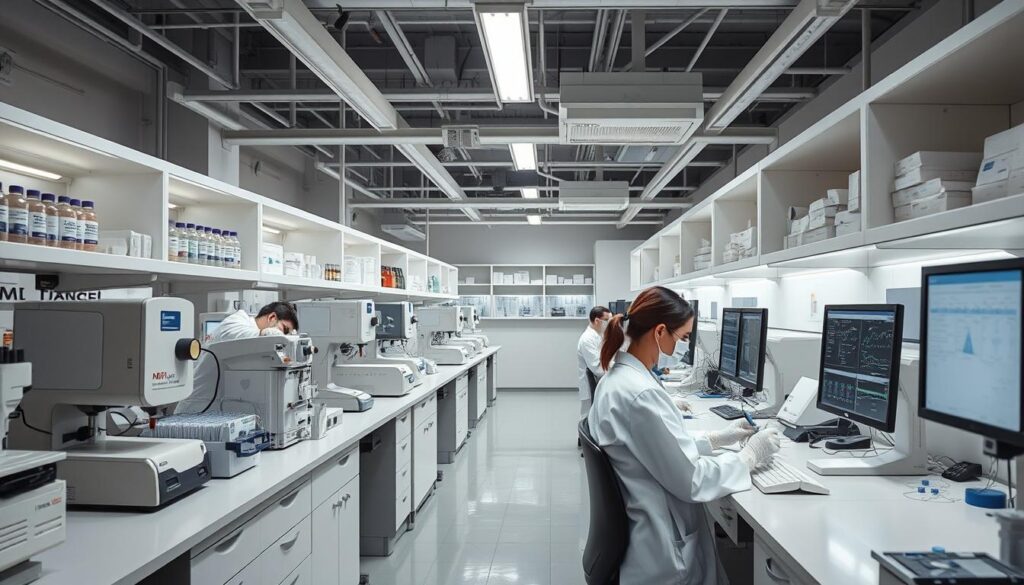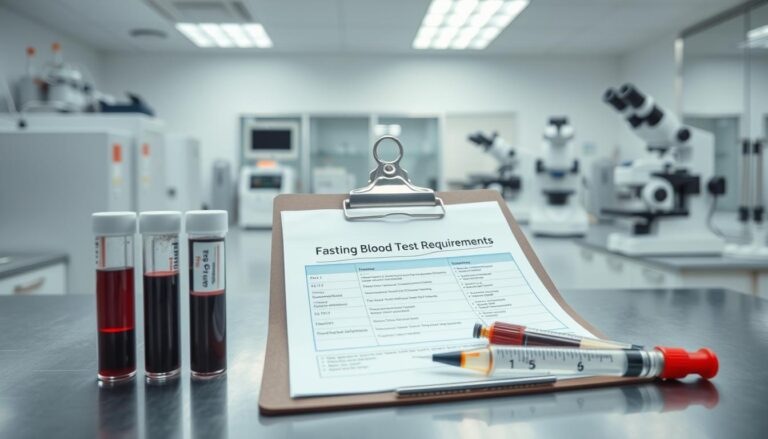Quality Control in Medical Laboratories: Process Overview
Imagine if a small mistake in a medical lab could alter a patient’s life. This thought highlights the critical role of quality control in medical labs. The process ensures lab results are accurate and reliable. It’s not just a must; it’s essential for our industry’s medical testing standards.
Every medical lab relies on quality control to protect test results. By using effective quality control, labs can reduce errors. This means patient results are more accurate and reliable. But what does this process involve, and how do we meet our medical testing standards? We’ll dive into the medical lab quality control process and why it’s key for patient care.

In the complex world of lab quality control, we must understand its various stages. From pre-analytical to post-analytical, each stage is vital. By knowing these stages and using effective procedures, labs can provide accurate results. This is essential for making informed medical decisions. Ensuring our labs meet the highest standards is our duty.
Understanding the Medical Lab Quality Control Process
Quality management in healthcare is key to making sure lab test results are right and trustworthy. Accreditation rules for labs are very important. They set the standards for keeping tests accurate. Labs must follow quality rules at every step of testing.
The quality control process has three main parts: before, during, and after testing. Each part has its own steps to keep mistakes low and results correct. For example, before testing, samples must be collected, labeled, and stored right. During testing, lab tools must be checked and kept in good shape.
Key Components of Quality Control
- Proper labeling and storage of samples to prevent mix-ups and contamination
- Regular maintenance and calibration of laboratory equipment
- Implementation of quality assurance protocols to ensure accuracy and reliability of results
Understanding these parts and using good quality control helps labs cut down on mistakes. This is vital for healthcare quality, as it affects patient care and treatment. It’s also key for diagnostic testing, making sure results are right for patient care decisions.
| Stage | Quality Control Measures |
|---|---|
| Pre-analytical | Proper labeling and storage of samples |
| Analytical | Regular maintenance and calibration of laboratory equipment |
| Post-analytical | Implementation of quality assurance protocols |
By sticking to these quality control steps and using good quality assurance, labs can make sure results are accurate. This is essential for quality in healthcare.
Implementing Effective Quality Control Measures
In the world of medical labs, quality control is key. It ensures our results are accurate and reliable. Quality assurance in labs is critical for patient trust. A good laboratory quality management system is essential for this.
Medical laboratory accreditation standards guide us. They help us meet quality control goals.
To ensure quality, we must take several steps. These include:
- Pre-analytical quality control steps, such as ensuring that samples are properly collected, labeled, and stored
- Analytical phase control procedures, such as calibrating laboratory equipment and following testing procedures correctly
- Post-analytical quality assurance, such as accurately reporting and interpreting results
- Documentation and record keeping, which are essential for ensuring that quality control measures are implemented correctly and that results are accurately reported
By following these steps and sticking to accreditation standards, we can make sure our results are trustworthy. This boosts patient care and our lab’s reputation.
Quality control also means training staff, managing inventory, and buying reagents together. These steps cut down on mistakes, make our lab run better, and build patient trust. Quality control is vital for top-notch patient care and our lab’s integrity.
Conclusion: Advancing Laboratory Excellence Through Quality Management
Quality control is key for accurate and reliable lab results. Labs can offer top-notch services by using good quality control. Each step, from start to finish, is vital for excellence.
Regular checks, tests, and new tech help labs cut down on mistakes. This makes work smoother and more efficient. Labs that keep improving and focus on quality do better in many ways. They work better, save money, and make customers happier.
As we go on, lab quality control will keep getting better. It will focus more on using data, following rules, and training staff. Labs that follow these steps will be ready for the challenges of healthcare. They’ll make sure their quality control is always the best.







